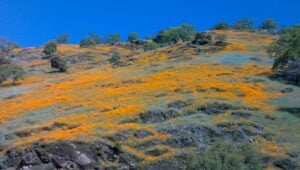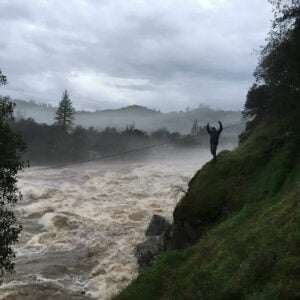
What do the classes mean?
Find out what the difference is between the various different classes of rapids and choose the one right for you!
Weather Report
“Will there be enough water for our rafting trip?” This is a question we often get. The short answer is YES! Even in the most severe of droughts we can guarantee that we will have raftable flows on the South Fork and Middle Fork of the American River. This is thanks to the 50-year Federal licenses that the dam system on these rivers operate under.
Some of you may be thinking, “How is this possible? If we are in a severe drought don’t we need this water for drinking, irrigation, etc.?” Yes, we do, but, the dam system upstream of the rafting sections on the South and Middle Forks of the American River are privately owned (i.e. PG&E, SMUD, etc.) hydroelectric dams. They are operated by business to produce and sell power, NOT to store water for drinking, etc… Don’t get me wrong, there is nothing wrong with that. Hydroelectricity can be a good source of power. The license does not stop these companies from producing power, it just means that they may not make as much money as they want since they will have to produce some power during non-peak hours while they release recreational flows for everyone to use (power companies get the most money per kilowatt during peak power demand hours). Seems like a fair enough compromise doesn’t it? They are making money off of public property (i.e. our rivers) after all. It is also not wasting any precious water for drinking, irrigation, etc., since water for these uses are pulled out of the system further downstream, NOT from the hydroelectric reservoirs. In fact, they have contracts with irrigation districts to release water from their reservoirs in order to deliver it to these districts.
When FERC issued a new license for the Upper American River Project (UARP) to PG&E and SMUD in 2014. It mandated a release schedule the guarantees raftable flows during the rafting season. The release schedule is determined by the classification of the water year (how much precipitation we received). There are 5 water year classifications: Super Dry, Critically Dry, Dry, Below Normal, Above Normal, and Wet. As an example, in 2016 at the end of California’s 5-year drought, the American River watershed was classified as having a “Below Normal” water year. In this situation the license required the recreational flow releases of 1300 cfs for 3 hours Monday, Tuesday, Thursday and Friday, and 1500 cfs for 6 hours Saturday and Sunday. If you have been rafting on the South Fork of the American River you are more than likely to have done it on 1300 cfs, this is roughly the flow 90% of the time during the rafting season no matter the water year (with the exception of a exceptionally wet year, i.e. 2017). And 3 hours of releases is more than enough time for you to enjoy your trip without even noticing a difference. That’s because the release begins at 9::00 a.m. and because of the way a river flows with drops and pools, when they stop releasing water it’s not like the rive drops like water draining out of your tub. Rather, the water slowly drains out of the furthest upstream pool before it drains out of the next pool. As an example, if Chili Bar Reservoir stops releasing 1300 cfs of water at 1:00 p.m. you will not see the water drop at Salmon Falls (20 miles downstream) until roughly 7:00 p.m… As you can see from the table below, even in the worst-case scenario, a “Super Dry” water year, there are required raftable releases 4 days a week from Memorial Day to Labor Day.
The 50-year FERC license for Oxbow Reservoir on the Middle Fork of the American River, operated by Placer County Water Agency (PCWA) is up for renewal and is currently being re-written. We know that there will be guaranteed recreational (raftable) flows mandated in the new license when it is finalized. As does PCWA, in fact for the last 10 plus years they have voluntarily provided recreational flows for rafting. In fact, in 2016 PCWA released recreational flows 7 days a week on the Middle Fork, while PG&E was mandated to release recreational flows 6 days a week on the South Fork. Since, Oxbow Reservoir only has 1 turbine it doesn’t produce that much power and so it isn’t an issue for PCWA to change it release schedule to accommodate recreational flows on the Middle Fork.
This is why we will always have water to go rafting on the South and Middle Forks of the American River, no matter what the water situation in California may be.

Find out what the difference is between the various different classes of rapids and choose the one right for you!

Weather Report Will there be Enought Water? “Will there be enough water for our rafting trip?” This is a question we often get. The short

South Fork Trips Meet at: 5461 Bassi Rd, Lotus, CA 95651
Water flows in the South Fork American River result from releases from hydroelectric facilities located upstream. Such water releases are not subject to the control of El Dorado County or rafting companies operating under Permits from the County of El Dorado.
Transportation for trips operated under California Public Utility Commission TCP# 0038955